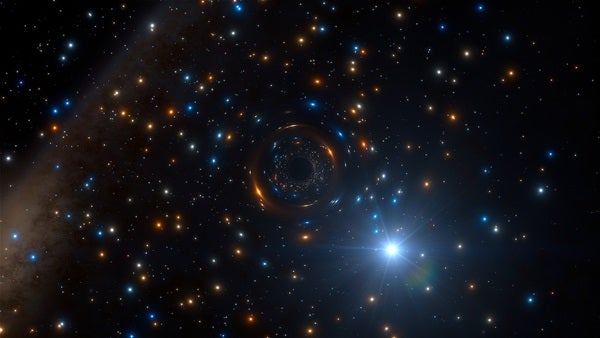Stellar-mass black holes — which weigh between a few and 100 times the mass of the Sun — speckle the universe. In our Milky Way alone, there are an estimated ten million to one billion stellar-mass black holes. That sounds like a lot, until you consider there are an estimated 100 to 400 billion stars in our galaxy.
But what exactly are stellar-mass black holes? And how do these mysterious voids in space differ from their supersized cousins?
Created by destruction
Not every star has the potential to become a black hole; only the most massive reach this coveted status. The smallest stellar-mass black holes come from stars packed with at least 2 to 3 times the mass of our Sun. (If you’re wondering, our petite Sun is too small to collapse into a black hole and instead will one day become a white dwarf).
Stars in the primes of their lives, like the Sun, burn hydrogen in their cores through a process known as nuclear fusion. This converts the hydrogen to helium and creates an outward pressure that counteracts the inward force of gravity. Following this hydrogen-burning phase, the most massive stars are hot enough to burn through their helium (just like less massive stars), then carbon, neon, oxygen, and, finally, silicon. After silicon, however, the star’s core is basically a hunk of iron, at which point no further energy can be unlocked through nuclear fusion. At this point, the inward crush of gravity has the upper hand.
In the most basic sense, the outer shell of the star, with no internal pressure to support it, implodes. For stars slightly more massive than the Sun, those collapsing outer layers rebound off the star’s core, detonating it as a supernova. But in the case of the most massive stars, nothing can stop the crushing collapse. Such stars are destined to become stellar-mass black holes upon their deaths.
But stellar old age isn’t the only way to form a black hole.
A white dwarf or neutron star remnant from a smaller star can also become a stellar-mass black hole, but it needs some help. It must syphon enough material from a nearby binary companion that it eventually climbs about the mass threshold needed to collapse into a black hole. Alternatively, the merger of a binary neutron star system could also create an object too massive to sustain itself as anything except a black hole.
There are also supermassive black holes, which weigh in at millions to billions of times the mass of the Sun. These gravitational Goliaths reside in the centers of most, if not all, galaxies. But although they are well documented, exactly how they first formed is still up for debate.
Anatomy of a monster
To really understand a black hole, you need to understand its anatomy.
At the center of a black hole lies the singularity, a theoretical point in space which has zero volume but contains all of the object’s mass. It is here that the black hole truly lives.
German theoretical physicist Karl Schwarzschild was the first to use Einstein’s theory of general relativity to show this point was mathematically possible. Encapsulating the singularity lies what most people picture when they think of a black hole: the event horizon. This is the spherical boundary beyond which nothing, not even light, can escape a black hole’s clutches.
However, contrary to the name, black holes are not (always) entirely invisible.
For years, these objects were only theorized because, by their nature, nothing can escape their clutches; they remained hidden. The only data that can be collected directly from a black hole is its spin and size. To find a black hole, researchers instead had to look at how these monsters interact with matter.
Ravenous, black holes consume anything that gets too close. And often, their plates overflow. That’s when the excess matter they’ve seized creates a hot swirling pool of doom around it called an accretion disk. This disk pulverizes everything within it, from gas to dust to asteroids to planets, and the material continues circling the black hole until it eventually gobbles it up. Because the dense rings of material can race around black holes at significant fractions of the speed of light, they get so hot that they emit X-rays, giving away the black hole’s position.
More recently, a secondary mode of detection was added to researcher’s toolbox, too: gravitational waves. When two black holes — or even a black hole and neutron star — collide, their merger sends out faint ripples in the fabric of space-time that scientists can now detect. Dozens of merging stellar-mass black holes have already been detected this way since 2015.
Still, an untold number of black holes (both stellar-mass and supermassive) lurk throughout the cosmos, influencing everything from nearby stars to galaxies themselves. But over the next few years, with the help of larger, more powerful telescopes and advanced gravitational-wave observatories like LIGO, scientists hope to continue exploring these mysterious and massive enigmas.











